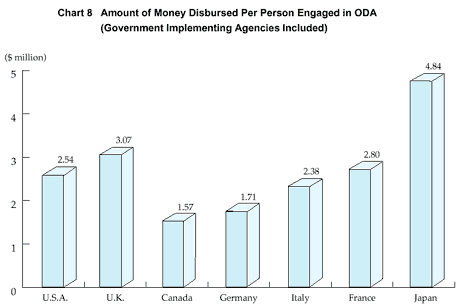Official Development Assistance (ODA)
15. Efforts to Provide More Efficient and Effective Aid
1. Formulation of Country Assistance Programs (the Country Approach)
- Providing effective aid that is based on an accurate understanding of local needs calls for a stronger country approach. Japan is currently pursuing in-depth studies concerned with country assistance programs for several target recipient countries. 33
- Stronger country approaches, however, demand that an extra effort be made to enlist the views and expertise of locally based embassy and aid personnel. To that end, it will be necessary to explore new frameworks involving MoFA's Economic Cooperation Bureau and aid agencies.
2. Aid Coordination
- Recent years have witnessed a heightened level of aid coordination among donors interested in improving the efficiency of their aid resources.
- With regard to countries that Japan has assigned priority for implementation of the new development strategy, Japan has been urging that donor consultations, sometimes with the recipient countries, be held at the local level for the purpose of aid coordination. 34
- Japan has been working together with the U.S. to coordinate aid policies under their Common Agenda framework, and also holds regular consultations for coordination purposes with various other donor countries, including Britain, France, Germany, the Scandinavian countries, Canada, Australia, the EU, and South Korea.
3. Stronger Grassroots Assistance
- Japan has a framework of grant aid assistance for grassroots projects, which is employed to encourage NGO participation in regional development, improve the benefits for local citizens at the grassroots level, and heighten the effectiveness of aid through cooperation from local communities. 35
4. Support for South-South Cooperation and Regional Cooperation
- South-South cooperation is an expression for the assistance that relatively advanced developing countries provide to their less-developed counterparts. It is an important means for strengthening cooperation at the regional and inter-regional levels.
- Japan has been an active supporter of South-South cooperation partly because this approach often facilitates the transfer of technologies that are well-suited to the recipient country's needs.
- Japan also provides financial and technical cooperation for "third country training" and "third country expert" programs. "Third-country training" programs are typically run in developing countries for trainees from other countries nearby. Third-country expert frameworks involve the assignment of developing-country personnel as experts. In FY 1997, 1,836 personnel received third-country training in 23 countries worldwide, including Asian countries such as Thailand, Singapore, and Brazil, Chile, and Egypt.
- Regional development cooperation is an additional approach that can be also effective in certain areas. In fact, a variety of projects are already under way to provide more effective aid in regions stretching across multiple national borders. For example, in February 1995 Tokyo hosted the Indochina Comprehensive Development Forum, in view of the importance of pursuing development through the entire region of the Mekong River Basin, an area that covers much of the Indochinese peninsula.
5. Measures in Disaster Relief
- In the event of a major natural disaster in a developing country or elsewhere, Japan is ready to donate tents, blankets, drugs, and other emergency supplies as well as to extend grant aid for disaster relief, and to send Japan Disaster Relief Teams to assist in rescue and recovery operations and provide medical care and emergency first aid.
- It is prepared to send emergency rescue teams and medical teams within 24 hours and 48 hours, respectively, of a request for such assistance.
- To date, 40 such Japan Disaster Relief Teams have been deployed abroad, and their performance highly praised by citizens in disaster-affected countries.
6. ODA Project Evaluations and Follow-Up Assistance
- Japan has been working to improve its ODA evaluation programs by enlisting third-party project evaluations (by outside experts, NGOs, and recipient-country personnel) and adopting a wider array of evaluation perspectives (e.g., evaluations of ODA at the sectoral and country levels).
- The results of its evaluations have been published every year since 1982 in the form of an Annual Evaluation Report on Japan's Economic Cooperation.
- Whenever an evaluation turns up problems in need of attention, Japan first urges the recipient country to take action. In some cases, though, Japan will, on the basis of adequate study, pursue follow-up measures, including the assignment of experts or the provision of spare parts.
7. Stronger Implementation Frameworks
- Japan will face the necessity of doing everything it can to reinforce its framework for aid project implementation in the years ahead if it intends to provided highly tailored and effective aid and fulfill a major role in coordinating aid with other donor countries. In addition, it will need to do more to ensure the safety and health of the aid personnel it assigns to projects overseas.
Note:
1. Total disbursements were divided by the number of assigned aid personnel.
2. Disbursed amounts are for 1997 (tentative DAC estimates). Personnel totals are for 1997
(or for 1997 fiscal years; some of the totals are estimates).
1. Total disbursements were divided by the number of assigned aid personnel.
2. Disbursed amounts are for 1997 (tentative DAC estimates). Personnel totals are for 1997
(or for 1997 fiscal years; some of the totals are estimates).
- Though country policies have already been worked out for 24 priority countries including China and Indonesia, more needs to be done in this area.
- See the discussion in section 11 on the new development strategy.
- This framework was introduced in 1989 as a source of comparatively small-scale financial assistance (from some hundreds of thousands of yen up to about 10 million yen) for aid projects implemented by municipal government organizations or NGOs (of diverse nationalities) active at the local project level in recipient countries. It has earned high marks as a means of providing direct assistance tailored to needs at the grassroots level. In FY 1997, it provided a combined total of about 5 billion yen in grants to 964 projects worldwide.

